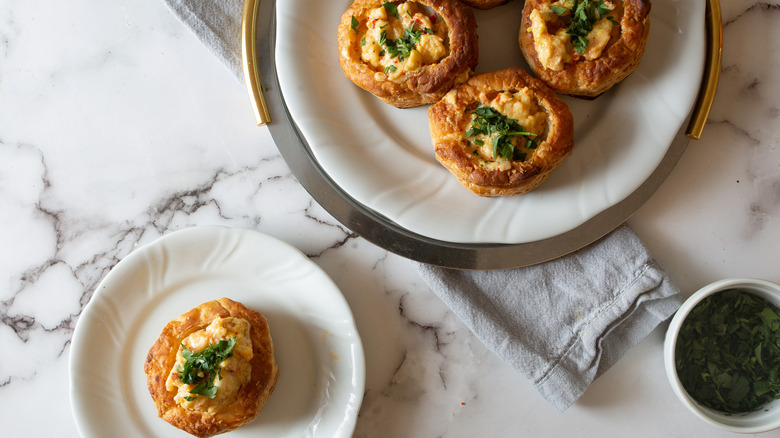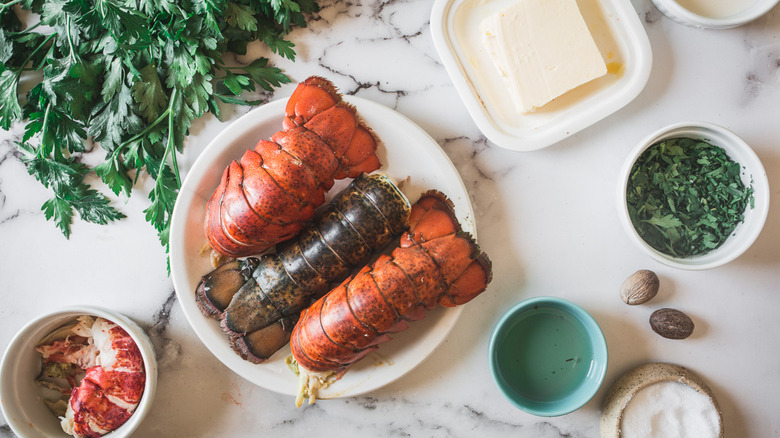Classic Lobster Newburg Recipe
Classic lobster Newburg is a fancy hors d'oeuvre that is surprisingly easy to make. It looks and feels like the perfect 1980s appetizer, made out of small puff pastry shells that are filled with lobster meat, cooked in cream and Madeira wine, and thickened with an egg. You can pop it in your mouth from a party tray in one or two bites, or grab a couple and pair them with a salad for a light lunch. What could be more decadent than that?
Yet this little appetizer is deceptively easy to make, says food blogger and photographer Ksenia Prints of At the Immigrant's Table. You'll be amazed to discover how quickly it comes together, and how good it tastes when it's all wrapped up in a pretty little puff pastry package.
Despite its European-sounding name, lobster Newburg is a classic American dish that is attributed to Delmonico's Restaurant in New York City, who allegedly named the dish in 1876 after a wealthy sea captain introduced them to this way of cooking lobster (via What's Cooking America). In its original iteration, lobster Newburg was served in chafing dishes at fancy family dinners and any restaurant that considered itself classy.
Nowadays, it's rare to find lobster Newburg on restaurant menus, but it remains a classic dinner party favorite. Serve it inside puff pastry shells or toast points for an easy, elegant appetizer that comes together in minutes. Consider making this delightful bite for your next impressive dinner party or get-together.
Gather the ingredients for classic lobster Newburg
First, let's get the answer to your big question out of the way: no, you do not need to cook a live lobster to make lobster Newburg. For this classic dish, you can use fresh lobster or lobster tail meat. You can also substitute frozen or even canned lobster meat for the fresh version. This makes a dish that used to be the purview of the rich and famous more accessible and affordable for the rest of us!
Other than lobster meat, we will use butter, egg yolks, heavy cream, and dry sherry or Madeira wine in our filling. The only seasoning we need is fresh parsley, salt, and nutmeg (or chili powder), a subtle slate of spices meant to not overpower the delicate flavor of the lobster meat.
Finally, to serve lobster Newburg, you can use puff pastry shells or even just a simple slice of toast. If using toast, it is customary to cut it into triangles or crustless squares for a classic neat visual presentation.
Prep the ingredients and separate the egg yolks
First, you'll need to gather and prep all the ingredients for lobster Newburg. Separate the egg yolks from the egg whites (and no need to throw them away, as you can use the whites later to make meringues, or even a healthy egg white omelet). Dice the parsley. If extracting your meat from fresh lobster, make sure you cut the lobster shell carefully and avoid cutting yourself. If using frozen puff pastry shells, arrange them on a baking sheet and bake according to package instructions. Otherwise, prepare the toast and set aside.
The rest of the ingredients require little manipulation, but we recommend you get them all measured out and organized by the stovetop, as the preparation of this dish goes fairly quickly. Plus, the trick of getting everything measured and set out ahead of time — often called mise en place — is a great habit to cultivate in your kitchen adventures.
Poach lobster meat in butter and cook the filling
Preheat a large pan to medium heat. Melt the butter in the pan and add in diced lobster meat. Cook for two minutes, stirring occasionally. Add in the Madeira wine or sherry and cook for an additional minute. Remove lobster meat from the pan and set aside. Move quickly and don't linger, as you don't want to overcook this delicate protein.
Now, into the pan, gradually add the cream to the remaining sauce, and whisk until the sauce thickens. Do not let the Newburg sauce come to a boil. This may cause it to split later on and will thin out the cream.
Temper egg yolks for lobster Newburg and add them to pan
Remove a tablespoon of sauce from the pan and add it to beaten egg yolks, stirring it in quickly. This is what's called "tempering" the eggs, a move that gradually raises their temperature and helps to ensure they don't curdle or scramble once added to the hot pan. Otherwise, the shock of the cold eggs coming into contact with a hot sauce can result in scrambled eggs, or at least a very grainy sauce.
Reduce the heat to low and gradually add the tempered egg yolks to the pan with the sauce. Stir in the yolks and continue cooking, stirring constantly, for two minutes.
Finish cooking the filling for lobster Newburg
Now that the egg yolks have been incorporated into the sauce, add the salt, followed by the nutmeg or chili powder to the pan. A few words about the spice choice you face here: nutmeg is often used as part of aromatic, creamy European dishes. It has a slight spice to it, but it mostly just adds a warm and fragrant undertone that helps lighten up very rich dishes. These days, chili powder can provide much of the same desired effect, but with a sharper, spicier flavor. If you're a fan of heat and spice, you may want to add the chili powder in place of the more traditional nutmeg.
Return the lobster meat back to the pan. If your sauce splits at this point, add more cream one tablespoon at a time and whisk to bind it again. Cook the lobster Newburg filling over low heat for one to two minutes more, just until lobster is heated through. Remove from heat.
Serve classic lobster Newburg in puff pastry shells or on toast points
Though in the past it was customary to keep lobster Newburg filling warm in chafing dishes, we recommend skipping this step and bringing it to the table immediately or alongside a delicious pastry with which you can soak up that creamy, wine-tinged sauce.
Serve classic lobster Newburg inside baked puff pastry shells or on top of toast (crustless triangles or squares are the traditional presentations). Sprinkle with fresh parsley immediately before serving.
Lobster Newburg is best eaten immediately. Though it will keep for a few days in the fridge in a sealed container, reheating it can result in a grainy sauce and soggy puff pastry shells.

- 3 egg yolks, beaten
- Fresh parsley, finely chopped, for serving
- ¼ cup butter or margarine
- 2 cups cooked lobster meat, cut into chunks (fresh, frozen, or canned)
- 3 tablespoons dry sherry or Madeira
- ¾ cup heavy cream
- ½ teaspoon salt
- 1 pinch ground nutmeg OR ground chili powder
- Puff pastry shells or toast, for serving
- Separate the egg yolks from the egg whites. Dice the parsley.
- Preheat a large pan to medium heat. Melt butter and add in lobster meat, and cook for two minutes, stirring occasionally. Add in the Madeira wine and cook for an additional minute.
- Remove lobster meat, gradually add in the cream, and whisk until the sauce thickens. Do not let the sauce come to a boil.
- Remove a tablespoon of sauce from the pan and add it to beaten egg yolks, stirring it in quickly. This helps temper the eggs to ensure they don't curdle or scramble once added to the hot pan.
- Reduce heat to low and add the egg yolks to the pan with the sauce. Cook, stirring constantly, for 2 minutes. Add the salt, spices, and lobster meat to the pan. If your sauce splits at this point, add 1 tablespoon of cream and whisk to bind it again.
- Cook over low heat for 1-2 minutes more, until the lobster is heated through. Remove from heat.
- Serve classic lobster Newburg inside baked puff pastry shells or on top of toast. Sprinkle with fresh parsley. Lobster Newburg is best eaten immediately.
| Calories per Serving | 297 |
| Total Fat | 24.7 g |
| Saturated Fat | 13.4 g |
| Trans Fat | 0.3 g |
| Cholesterol | 197.6 mg |
| Total Carbohydrates | 6.5 g |
| Dietary Fiber | 0.2 g |
| Total Sugars | 1.0 g |
| Sodium | 265.5 mg |
| Protein | 10.8 g |







